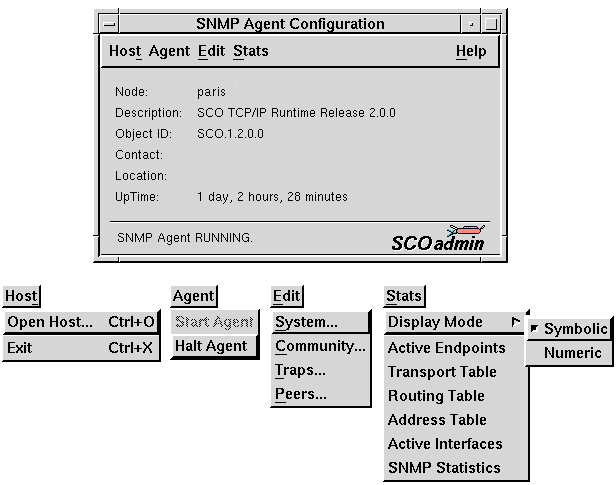
|
|
Use the SNMP Agent Manager to:
The SNMP Agent Manager allows you to perform most SNMP configuration graphically. You can start the SNMP Agent Manager in any of these ways:
The SNMP Agent Manager's top level and menus are illustrated here:

To configure SNMP:
To limit the list to those hosts matching a certain pattern, enter the pattern (including wildcard characters) in the ``Filter'' field, then click on Filter. Then, select the host name from the list and click on OK.
To sort the list by name or address, click on the appropriate radio button.
The system group contains the basic information that the SNMP agent needs. These are:
Generally, only the latter three items need to be updated.
Enter the appropriate information in each field, and click on OK when done.
The last item, SMUX reserved classes, allows you to specify those SMUX MIB classes that may only be managed by the local agent. Any classes not listed here may be, but will not necessarily be, managed by other SNMP agents.
When you make changes to the system group using the SNMP Agent Manager, the information is placed into the file /etc/snmpd.conf:
Sample snmpd.conf file
descr=SCO TCP/IP Runtime Release 2.0.0 objid=SCO.1.2.0.0 contact=Trevor Jones x 256 location=First Floor Computer Room smux_reserved=your_company
An SNMP community is a group of hosts that you can manage as a distinct group with SNMP.
The SNMP communities group contains a list of community/IP address pairs identifying those management stations from which the agent on the local host accepts queries. Along with each pair is an access field that controls whether access is allowed, and if so, whether the access granted is read-only or read-write. In addition, the special community public, with an address of 0.0.0.0, restricts or allows access to all other members of the public community.
With the Community Names Editor of the SNMP Agent Manager, you can:
The changes you make are saved to the file /etc/snmpd.comm
when you click on OK in the information screen.
By default, this file originally contains one
entry: public 0.0.0.0 read. This allows
read access to all members of the public community.
The following is an example of /etc/snmpd.comm. In this example, system 10.0.118.6 of community ``your_company.rivers'' is allowed read access only, whereas system 10.0.246.1 of community ``your_company.cities'' is allowed read and write access. Note that the public community default read access has been changed to no access.
Sample snmpd.comm file
# community address access # public 0.0.0.0 none your_company.rivers 10.0.118.6 read your_company.cities 10.0.246.1 write
The trap group contains a list of community/IP address pairs identifying those management stations to which the agent sends traps following unusual events, such as a ``cold start''. The trap IP port can also be modified; its default value is 162.
With the Trap Configuration Editor of the SNMP Agent Manager, you can:
The changes you make are saved to the file /etc/snmpd.trap when you click on OK in the information screen:
Sample snmpd.trap file
# community address port # your_company.rivers 10.0.118.1 162 your_company.cities 10.0.246.1 162
See also:
The peers group contains a list of SMUX peers known to the local SNMP agent. This information is needed only to enable the agent to communicate with a SMUX peer that exports a specific MIB module. Fields include:
With the Peers Configuration Editor of the SNMP Agent Manager, you can:
The changes you make are saved to the file /etc/snmpd.peers when you click on OK in the information screen:
Sample snmpd.peers file
# # <name> <object-id> <password> [<priority>] # "gated" 1.3.6.1.4.1.2.3.1.2.1.2 "gated_password" "foo" 1.3.6.1.4.1.4.3.99 "aintNoThing" -1
See also: